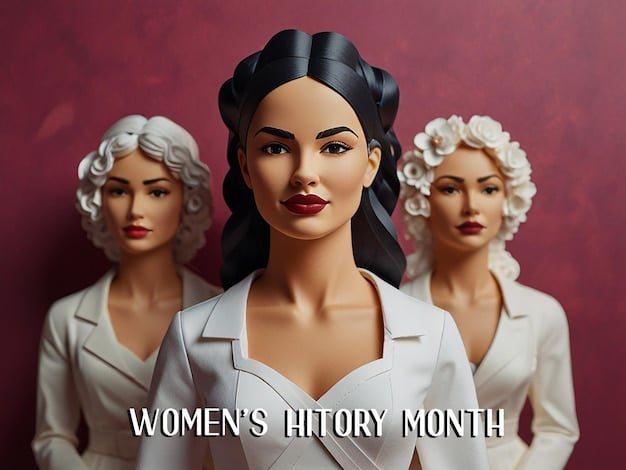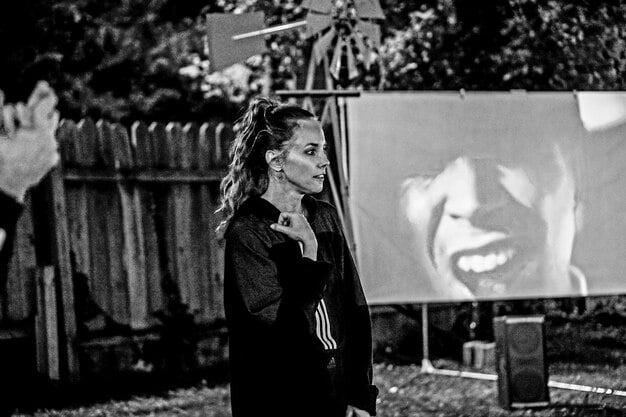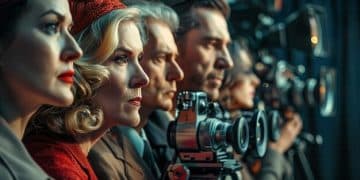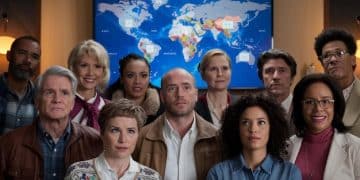The Rise of the Female Director: Hollywood’s Breakthrough

The rise of the female director in Hollywood showcases a significant shift, as women overcome historical barriers to achieve recognition and influence in shaping contemporary cinema.
The film industry, once a bastion of male dominance, is undergoing a seismic shift. The spotlight is now shining brighter than ever on the rise of the female director: breaking barriers in Hollywood. This isn’t just a trend; it’s a cultural movement reshaping storytelling and challenging long-held biases, and we’re here to explore it.
The Historical Context of Women in Hollywood
For decades, Hollywood relegated women to stereotypical roles both on and off-screen. Opportunities for female directors were scarce, and their contributions were often overlooked or undervalued. Understanding this historical context is crucial to appreciating the magnitude of the current shift.
Early Pioneers and Their Struggles
In the early days of cinema, women like Alice Guy-Blaché were instrumental in shaping the art form. Despite their innovative work, they faced significant challenges in gaining recognition and maintaining their positions in a male-dominated industry.
- Limited Access: Women had limited access to funding, resources, and mentorship opportunities.
- Gender Bias: Deep-seated gender biases often led to their work being dismissed or attributed to male colleagues.
- Lack of Support: The industry lacked support systems for women, making it difficult for them to advance their careers.
As the studio system solidified, the role of women in directing diminished further, reinforcing the idea that directing was a man’s job. This historical exclusion laid the groundwork for the systemic barriers that female directors continue to face today.

Breaking the Glass Ceiling: Key Moments and Milestones
Despite the challenges, female directors have persistently chipped away at the glass ceiling, achieving significant milestones that paved the way for future generations. These moments represent crucial turning points in the fight for gender equality in Hollywood.
Landmark Films Directed by Women
Films like “Yentl” (1983), directed by Barbra Streisand, and “Big” (1988), directed by Penny Marshall, proved that women could direct commercially successful and critically acclaimed movies. These successes helped break down the perception that women were only suited for certain types of films.
The Rise of Independent Cinema
The independent film movement provided a fertile ground for female directors to showcase their talent. Directors like Jane Campion (“The Piano”) and Sofia Coppola (“Lost in Translation”) gained recognition for their unique voices and perspectives.
- Increased Opportunities: Independent cinema offered more opportunities for female directors to gain experience and visibility.
- Creative Freedom: The independent scene allowed for more creative freedom and experimentation.
- Critical Acclaim: Many female-directed independent films received critical acclaim and awards, boosting their careers.
These key moments and milestones demonstrated the potential of female directors and inspired others to pursue their passion, challenging the status quo and demanding greater representation in the industry.
Contemporary Female Directors Making Waves
Today, a new generation of female directors is making significant waves in Hollywood, achieving critical acclaim, commercial success, and breaking down barriers in the process. Their diverse backgrounds and unique storytelling styles are enriching the cinematic landscape.

Spotlight on Greta Gerwig
Greta Gerwig has emerged as one of the most influential directors of her generation. Her films, such as “Lady Bird” and “Little Women,” have garnered critical acclaim for their authentic portrayals of female characters and their witty, insightful writing.
Ava DuVernay’s Impact
Ava DuVernay has made a significant impact with her powerful storytelling and commitment to social justice. Her films, including “Selma” and “13th,” have shed light on important issues and challenged audiences to confront uncomfortable truths.
- Breaking Stereotypes: These directors are breaking stereotypes and challenging traditional gender roles in their films.
- Amplifying Voices: They are amplifying the voices of marginalized communities and telling stories that reflect the diversity of human experience.
- Inspiring Others: Their success is inspiring other women and girls to pursue their dreams in the film industry.
The contributions of these contemporary female directors are reshaping Hollywood and inspiring future generations of filmmakers, proving that diverse voices are essential for creating meaningful and impactful cinema.
The Challenges That Still Exist
Despite the progress made, female directors continue to face significant challenges in Hollywood. Systemic biases, lack of equal opportunities, and unequal pay remain persistent obstacles that hinder their advancement.
The Gender Pay Gap
Female directors often face a gender pay gap, earning less than their male counterparts for similar work. This disparity reflects the broader undervaluation of women’s contributions in the industry.
Lack of Representation Behind the Camera
Even today, female directors are underrepresented behind the camera, particularly in high-budget studio films. This lack of representation limits their opportunities to gain experience and advance their careers.
- Implicit Bias: Implicit bias in hiring practices often leads to women being overlooked for directing jobs.
- Limited Networks: Women often lack access to the same professional networks as men, making it harder for them to find work.
- Stereotypes: Stereotypes about women’s leadership abilities can negatively impact their career prospects.
Addressing these challenges requires a concerted effort from all stakeholders in the industry, including studios, producers, and talent agencies, to create a more equitable and inclusive environment for female directors.
Initiatives Supporting Female Filmmakers
Recognizing the need for change, various initiatives have emerged to support female filmmakers and promote gender equality in Hollywood. These programs provide resources, mentorship, and networking opportunities to help women succeed in the industry.
Mentorship Programs and Workshops
Several organizations offer mentorship programs and workshops specifically designed to support female directors. These initiatives provide guidance, training, and networking opportunities to help women navigate the challenges of the industry.
Film Festivals and Grant Programs
Film festivals like the Sundance Film Festival and grant programs like the ones offered by the Academy of Motion Picture Arts and Sciences provide platforms for female directors to showcase their work and receive funding for their projects.
- Creating Opportunities: These initiatives create opportunities for female filmmakers to showcase their talent and gain visibility.
- Providing Resources: They provide access to funding, mentorship, and networking opportunities.
- Promoting Diversity: They promote diversity and inclusion in the film industry.
By supporting these initiatives, the industry can create a more level playing field and ensure that talented female filmmakers have the resources and opportunities they need to thrive.
The Future of Female Directors in Hollywood
The future of female directors in Hollywood looks promising, with increased awareness of gender inequality and a growing commitment to creating a more inclusive and equitable industry. Continued progress will depend on sustained efforts from all stakeholders.
The Impact on Storytelling
As more female directors gain prominence, the stories told on screen are becoming more diverse and representative of the human experience. This shift is enriching the cinematic landscape and challenging traditional narratives.
The Importance of Continued Advocacy
Continued advocacy for gender equality is essential to ensure that female directors continue to break barriers and achieve their full potential. This includes advocating for equal pay, increased representation, and a more inclusive industry culture.
- Breaking Down Barriers: By challenging stereotypes and biases, female directors are breaking down barriers for future generations.
- Creating Role Models: They are creating role models for other women and girls who aspire to careers in filmmaking
- Transforming the Industry: Their contributions are transforming the film industry into a more diverse, equitable, and inclusive space.
By embracing diversity and supporting female filmmakers, Hollywood can ensure that the future of cinema is one that reflects the richness and complexity of the world we live in. The rise of the female director: breaking barriers in Hollywood is not just a trend; it’s a fundamental shift that is reshaping the industry for the better.
| Key Point | Brief Description |
|---|---|
| 🎬 Historical Context | Women faced limited opportunities and bias. |
| 🌟 Key Milestones | Landmark films and independent cinema success. |
| 👩 Directors Today | Greta Gerwig, Ava DuVernay, and others make waves. |
| ⚖️ Ongoing Challenges | Pay gap and representational issues persist. |
FAQ
▼
Early challenges included limited access to funding and resources, significant gender bias, and a general lack of industry support. These barriers made it difficult for women to advance their careers.
▼
Alice Guy-Blaché, was instrumental in shaping early cinema. Barbra Streisand (“Yentl”) and Penny Marshall (“Big”) directed commercially successful films, defying expectations of women directors.
▼
Independent cinema provided more opportunities and greater creative freedom. Directors like Jane Campion and Sofia Coppola gained recognition here, allowing them to express unique voices and perspectives effectively.
▼
Many mentorships, film festivals (like Sundance), and grant programs support women. The Academy of Motion Picture Arts and Sciences also provides resources and platforms for female directors to display their work.
▼
The future is optimistic, emphasizing more inclusive storytelling and breaking stereotypes. Continued advocacy, equal pay, and increased representation are essential, which create inspiring role models for diverse and equitable space.
Conclusion
The journey of female directors in Hollywood has been one of resilience, perseverance, and groundbreaking achievements. While challenges remain, the progress made is undeniable. The future of cinema is undoubtedly brighter as we continue to champion and celebrate the voices of talented female filmmakers, fostering a more inclusive and representative industry for all.





